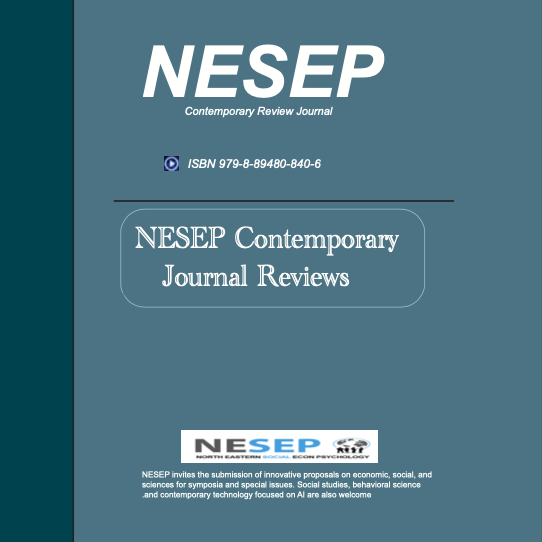Accepted Articles
We congratulate you on acceptance of your manuscript.

Annual Expo by the Journal of Young Explorers Meta and NESEP
- Fundamental or applied research
- Interdisciplinary research
- Judging on a rolling basis
- A work-in-progress research
- Completed research
- Unlimited topics and ideas
- ISBN 979-8-89480-840-6
- NESEP/NY-CSEF event at Harvard Club in NYC
An Examination of the Relationship Between the Types of News Media Usage and
Abstract: The expansion of the digital world in the 21st century has caused an expansion of the less traditional forms of news media, namely the forms of current events information accessible on social media applications such as TikTok and Instagram. Unlike the previous generations, the younger
generation raised in the 21st century has access to many digital resources, and despite their convenience, a slew of studies have found that there is a severe threat of misinformation when using digital or non-traditional forms of news media. This study sought to discover if there is a relationship between the level of geographic literacy and global awareness demonstrated by high school students and their means of accessing current events
information. In October of 2022, participants (n=114) completed an online survey which assessed them on their geographic literacy and global awareness of the democratic and economic conditions of ten
selected countries. The survey also asked each respondent to rank the type of media through which they are most likely to learn about current events on a Likert scale from 1-5. The SMPM (Social Media Preference Metric) was then determined, which was a binary variable used to run the correlation tests.
The data collected was transferred into Microsoft Excel, where ANOVA tests were run on both the SMPM v. raw scores and the SMPM v. ranking deviation values. The results of this study show that the use of digital and unverified forms of news media are unable to be correlated with a lack of geographic literacy and understanding of democratic development, but that there is a strong correlation between the use of social media as a news source over verified, traditional forms and a lack of understanding of the economic development in foreign nations.
Reference
Berndt, A. (2007). Media habits among Generation Y consumers. In A.S.A du Toit, (Ed.). Proceedings of the 19th Annual Conference of the Southern African Institute of Management Scientists. Johannesburg,
South Africa, 19-21 September 2007, Accessed 11/22/22
Chatham House. “The importance of democracy: Why is democracy important to the world and how does
it help maintain a just and free society?” [Online]
https://www.chathamhouse.org/2021/04/importance-democracy, Accessed 9/20/22
Dikmenli, Yurdal. “Geographic Literacy Perception Scale (GLPS) Validity and Reliability Study.” Mije.mevlana.edu.tr., Mevlana International Journal of Education (MIJE) Vol. 4(1), Pp. 1-15, 1 April, 2014 , 1 Apr. 2014.
Economist Intelligence Unit. Democracy Index 2021: The China Challenge.” [Online] https://pages.eiu.com/rs/753-RIQ-438/images/eiu-democracy-index-2021.pdf?mkt_tok=NzUzLVJJUS00 MzgAAAGG-g5-q-P9q5lVTxU_bLCcYMAS75hY0AAn7tW7xt69fd0eM7cchj590Oqm4lhjsHhfySkFy__XSnHjQ3fHGkzAaVCwHkqVlGmv1T6DPPR2FZh9fw, Retrieved 9/20/22.
Francek, Mark A. Burton D. Nelson, Robert H. Aron & Walter J. Bisard (1993) The Persistence of Selected Geographic Misperceptions: A Survey of Junior High Through Undergraduate College Students,
Journal of Geography, 92:6, 247-253, DOI: 10.1080/00221349308979666
Fresno Pacific University. “What is Global Awareness And Why Does It Matter?” [Online] https://ce.fresno.edu/news/what-is-global-awareness-and-why-does-it-matter/, Retrieved 9/20/22
Haavenson, P, Savukova, G, & Mason, T. (1998/99). Teacher education reform and global education: United States and Russian perspectives. The International Journal of Social Education, 13, 2947.
Jordaan, Y. et al. (2011). “Advertising credibility across media channels: perceptions of Generation Y consumers.” [Online], Department of Marketing and Communication Management at the University of Pretoria, Pretoria, South Africa, July 2011 https://journals.co.za/doi/pdf/10.10520/EJC27752, Accessed 11/22/22
Kirkwood, T. (2001). Our global age requires global education: Clarifying definitional ambiguities. Social Studies, 92, 116.
Lauer, D. (2020). Facebook’s ethical failures are not accidental; they are part of the business model. Ai and Ethics, 1(4), 395-403. https://doi.org/10.1007/s43681-021-00068-x
Merryfield, M. (2002). Rethinking our framework for understanding the world. Theory & Research in Social Education, Winter 2002, 148151.
Seock, Y-K. & Chen-Yu, J.H. (2007). Website evaluation criteria among US college student consumers with different shopping orientations and Internet channel usage. International Journal of Consumer Studies, Accessed 11/22/22
Stanford History Education Group & Robert McCormick Foundation, Evaluating Information Online. 21 Nov. 2016, https://stacks.stanford.edu/file/druid:fv751yt5934/SHEG%20Evaluating%20Information%20Online.pdf.
Spector, Carrie. “High School Students Are Unequipped to Spot 'Fake News'.” Stanford News, 18 Nov. 2019, https://news.stanford.edu/2019/11/18/high-school-students-unequipped-spot-fake-news/.
Snavely, L. and N. Cooper. 1997.The information literacy debate.The Journal of Academic Librarianship, 23(1), (9-13).
Sterk, Dr. Amanda. “Beyond the Classroom: The Benefits of Global Awareness for Teens.” College UnMazed, College UnMazed, 22 Sept. 2019,
http://www.unmaze.me/community/2019/9/22/beyond-the-classroom-the-benefits-of-global-awareness-for-teens.
Steyer, James P. “The Common Sense Census: Media Use by Tweens and Teens, 2021.” Common Sense Media, Media Use by Tweens and Teens, 22 Mar. 2022, https://www.commonsensemedia.org/research/the-common-sense-census-media-use-by-tweens-and-teens-2021.
Torrens, Paul M. Where in the World? Exploring the Factors Driving Place Location Knowledge among Secondary Level Students in Dublin, Ireland. Journal of Geography, 28 Sept. 2007.